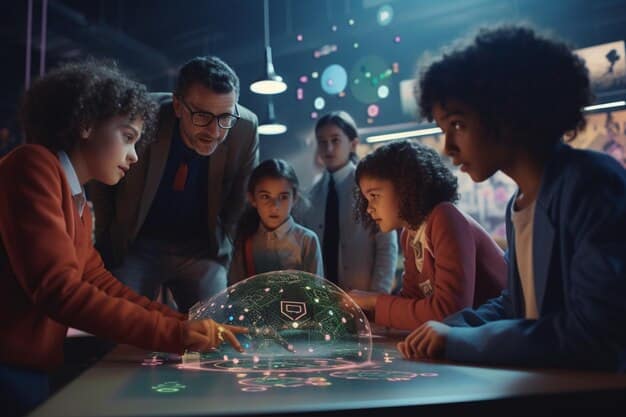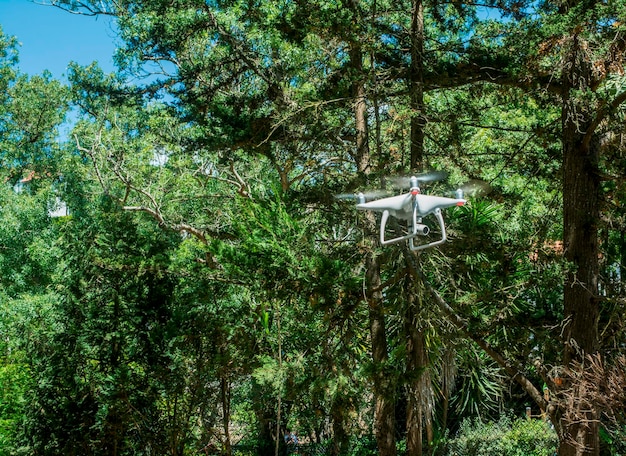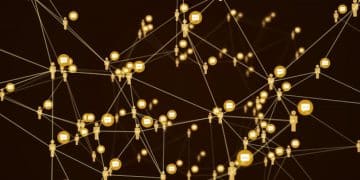How AI Can Drive Social Good: Real-World Applications & Benefits

AI can be used to promote social good through various applications, including improving healthcare access, enhancing education, addressing climate change, promoting human rights, and aiding in disaster response, ultimately contributing to a more equitable and sustainable world.
Artificial intelligence is rapidly transforming our world, and while concerns about its potential misuse are valid, its capacity to be a force for good is immense. This article explores how AI can be used to promote social good across various sectors, offering real-world examples and highlighting its potential to address some of the world’s most pressing challenges.
Understanding the Potential of AI for Social Impact
Artificial intelligence (AI) has moved beyond science fiction and into our daily lives, impacting industries from finance to transportation. However, its most profound potential lies in its ability to address social challenges and contribute to the greater good. By leveraging AI’s analytical capabilities, predictive power, and automation potential, we can tackle complex issues more effectively than ever before.
This section will explore the broad scope of AI applications for social good and lay the groundwork for understanding its transformative potential.
AI’s Analytical Capabilities: A Foundation for Change
AI’s capacity to analyze vast datasets and identify patterns far exceeds human capabilities. This powerful analytical ability can be applied to complex social issues, providing insights that would otherwise remain hidden.
For example, AI algorithms can analyze crime statistics to identify hotspots and predict future incidents, allowing law enforcement to allocate resources more effectively. Similarly, AI can analyze public health data to identify disease outbreaks and develop targeted interventions.
Predictive Power and Proactive Solutions
Beyond analysis, AI can also predict future trends and outcomes, enabling proactive interventions. By identifying potential problems before they escalate, AI can help us to prevent crises and improve outcomes.
In the realm of environmental protection, AI can predict deforestation rates and identify areas at high risk, allowing conservationists to focus their efforts and prevent further damage. In education, AI can predict student performance and identify those who may need additional support, enabling teachers to provide personalized instruction and improve learning outcomes.
Here are key areas where AI’s potential can be harnessed:
- Data Analysis: AI excels at processing large datasets to uncover trends and insights.
- Predictive Modeling: AI algorithms can forecast future events and outcomes with remarkable accuracy.
- Automation: AI can automate repetitive tasks, freeing up human resources for more strategic work.
- Personalization: AI can tailor solutions to individual needs, improving effectiveness and engagement.
In conclusion, the potential of AI for social impact is immense. By leveraging its analytical capabilities, predictive power, and automation potential, we can tackle complex social issues more effectively and create a more equitable and sustainable world.

Improving Healthcare Access and Outcomes with AI
Healthcare is an area ripe for AI innovation. From improving diagnostics to personalizing treatments and expanding access to care, AI has the potential to revolutionize healthcare and improve outcomes for millions of people.
This section will delve into specific examples of how AI is being used to address healthcare challenges, focusing on accessibility, efficiency, and accuracy.
AI-Powered Diagnostics and Early Detection
AI algorithms can be trained to analyze medical images, such as X-rays and MRIs, to detect diseases like cancer at an early stage. This early detection dramatically increases the chances of successful treatment.
For instance, AI systems are now capable of identifying subtle anomalies in mammograms that might be missed by human radiologists, leading to earlier diagnosis and treatment of breast cancer. Similarly, AI can analyze retinal scans to detect early signs of diabetic retinopathy, a leading cause of blindness.
Personalized Treatment Plans and Precision Medicine
AI can analyze patient data, including genetic information, medical history, and lifestyle factors, to develop personalized treatment plans that are tailored to the individual’s specific needs. This approach, known as precision medicine, can lead to more effective treatments and fewer side effects.
For example, AI can help oncologists to select the most effective chemotherapy drugs for a particular patient based on their genetic profile. In mental health, AI can analyze patient’s speech patterns and emotional cues to personalize therapy and improve outcomes.
Key applications of AI in healthcare include:
- Remote Diagnostics: AI-powered tools can enable remote diagnosis and monitoring, particularly in underserved areas.
- Drug Discovery: AI accelerates the drug discovery process by analyzing vast amounts of data and identifying potential drug candidates.
- Personalized Medicine: AI helps tailor treatment plans to individual patient needs based on their unique characteristics.
- Efficient Administration: AI automates administrative tasks, freeing up healthcare professionals to focus on patient care.
In conclusion, AI is transforming healthcare by improving access, efficiency, and outcomes. From early disease detection to personalized treatment plans, AI has the potential to revolutionize healthcare and create a healthier world for all.
Enhancing Education and Personalized Learning Experiences
Education is another sector where AI can have a profound impact. By personalizing learning experiences, providing automated feedback, and improving access to educational resources, AI can empower students and teachers alike.
This section will explore how AI is being used to enhance education and create more effective and engaging learning environments.
AI-Driven Personalized Learning Platforms
AI-powered platforms can analyze student’s learning styles, strengths, and weaknesses to create personalized learning paths. These platforms can adapt to the student’s pace and provide customized content and feedback.
For example, AI tutoring systems can identify areas where a student is struggling and provide targeted instruction and practice exercises. These systems can also track student progress and adjust the difficulty level accordingly, ensuring that the student is always challenged but not overwhelmed.
Automated Feedback and Grading Systems
AI can automate the process of grading assignments and providing feedback, freeing up teachers’ time and allowing them to focus on more personalized instruction.
For instance, AI systems can automatically grade multiple-choice tests and provide detailed feedback on essay assignments. These systems can also identify common errors and misconceptions, allowing teachers to address them in their lessons.
AI applications can support education through:
- Adaptive Learning: AI tailors educational content to individual student needs and learning styles.
- Automated Assessment: AI streamlines grading processes and provides instant feedback to students.
- Virtual Tutors: AI-powered tutors offer personalized guidance and support to students.
- Accessibility Tools: AI enhances accessibility for students with disabilities through tools like text-to-speech.
In summary, AI is revolutionizing education by personalizing learning experiences, automating administrative tasks, and improving access to educational resources. By empowering students and teachers with AI-powered tools, we can create a more effective and equitable education system for all.
Addressing Climate Change and Environmental Sustainability
Climate change is one of the most pressing challenges facing humanity, and AI can play a critical role in addressing this crisis. From optimizing energy consumption to predicting extreme weather events and monitoring deforestation, AI can provide valuable insights and solutions.
This section will explore how AI is being used to address climate change and promote environmental sustainability.

AI for Optimizing Energy Consumption
AI can optimize energy consumption in buildings, transportation systems, and industrial processes, reducing greenhouse gas emissions and saving money.
For example, AI-powered smart grids can optimize the distribution of electricity, reducing transmission losses and improving the efficiency of renewable energy sources. In buildings, AI can control lighting, heating, and cooling systems to minimize energy consumption based on occupancy patterns and weather conditions.
Predicting Extreme Weather Events and Natural Disasters
AI can analyze weather data to predict extreme weather events, such as hurricanes, floods, and droughts, allowing communities to prepare and mitigate their impact. This can save lives and reduce property damage.
Predictive Modeling and Mitigation Strategies include:
- Climate Modeling: AI enhances climate models to predict long-term trends and inform policy decisions.
- Disaster Prediction: AI algorithms forecast natural disasters, enabling timely evacuations and resource allocation.
- Renewable Energy Optimization: AI optimizes energy production and distribution for renewable sources like solar and wind.
- Smart Grids: AI manages energy consumption and distribution in real-time, reducing waste and improving efficiency.
In conclusion, AI is a powerful tool for addressing climate change and promoting environmental sustainability. By optimizing energy consumption, predicting extreme weather events, and monitoring deforestation, AI can help us to protect our planet and create a more sustainable future.
Promoting Human Rights and Social Justice with AI
AI has the potential to promote human rights and social justice by detecting discrimination, monitoring human rights violations, and providing access to legal information and assistance.
This section will explore how AI can be used to advance human rights and create a more just and equitable society.
Detecting Discrimination and Bias in Algorithms
AI algorithms can perpetuate and amplify existing biases in society, leading to discriminatory outcomes in areas such as hiring, lending, and criminal justice. AI can be used to detect and mitigate these biases, ensuring that algorithms are fair and equitable.
For example, AI can analyze hiring algorithms to identify patterns of discrimination against certain groups. It can also be used to develop bias-detection tools that can be integrated into existing AI systems.
Monitoring Human Rights Violations
AI can be used to monitor human rights violations, such as police brutality, hate speech, and online harassment. AI algorithms can analyze social media posts, news articles, and other data sources to identify potential violations.
Key applications of AI in social justice include:
- Bias Detection: AI algorithms identify and correct biases in automated systems to ensure fairness.
- Legal Assistance: AI provides access to legal information and resources for underserved communities.
- Human Rights Monitoring: AI tracks and reports human rights abuses by analyzing data from various sources.
- Fair Lending Practices: AI ensures equitable lending practices by detecting and preventing discriminatory loan algorithms.
AI can be a powerful tool for promoting human rights and social justice, but it is crucial to ensure that AI systems are developed and used ethically and responsibly. Collaboration between AI experts, human rights advocates, and policymakers is essential to ensure that AI serves the interests of all members of society.
Aiding in Disaster Response and Humanitarian Assistance
When disasters strike, timely and effective response is critical. AI can play a vital role in disaster response and humanitarian assistance by predicting disasters, coordinating relief efforts, and providing real-time information to responders and affected populations.
This section will explore how AI can be used to improve disaster response and humanitarian aid.
Predicting Disasters and Optimizing Resource Allocation
AI can analyze weather data, seismic activity, and other factors to predict natural disasters, such as hurricanes, earthquakes, and floods. This allows authorities to issue timely warnings and prepare for potential emergencies.
AI can also optimize the allocation of resources during disaster response by identifying areas that are most in need of assistance. For example, AI can analyze social media posts and satellite imagery to assess the extent of damage and identify locations where people are trapped or injured.
Core benefits of AI in disaster response and humanitarian assistance are:
- Predictive Analysis: AI forecasts disasters to enable early warnings and preparations.
- Resource Allocation: AI optimizes the distribution of aid and resources based on real-time needs.
- Coordination: AI facilitates communication and coordination among various relief agencies.
- Damage Assessment: AI analyzes data to quickly assess the scope and impact of disasters.
In conclusion, AI is a valuable tool for aiding in disaster response and humanitarian assistance. By predicting disasters, coordinating relief efforts, and providing real-time information, AI can help save lives and alleviate suffering in the aftermath of a crisis. As AI technology continues to advance, its role in disaster response and humanitarian aid will only become more important.
| Key Aspect | Brief Description |
|---|---|
| ⚕️ Healthcare | AI improves diagnostics, personalizes treatment, and increases healthcare access. |
| 📚 Education | AI personalizes learning, automates feedback, and enhances educational resources. |
| 🌍 Environment | AI helps optimize energy use, predict weather, and monitor deforestation. |
| ⚖️ Justice | AI detects bias, monitors human rights, and offers access to legal aid. |
Frequently Asked Questions
▼
AI helps predict disasters, allocate resources efficiently, and coordinate relief efforts. It analyzes data for quick damage assessment and aids in effective rescue operations.
▼
Yes, AI can analyze a student’s learning style, strengths, and weaknesses to tailor a unique learning path. This includes customized content and automated feedback, improving educational outcomes.
▼
AI optimizes energy consumption, predicts extreme weather, and monitors deforestation. AI also assists in managing resources and enables smarter, cleaner energy grids, contributing to sustainability.
▼
AI can detect biases in algorithms by analyzing and identifying patterns of discrimination. Bias-detection tools can then be integrated into existing AI systems to promote fairness and equity.
▼
AI can make a social impact in healthcare, education, environmental sustainability, and social justice. Improvements in these key areas contribute to a more equitable and sustainable world .
Conclusion
As we’ve explored, the potential of AI to drive social good is vast and spans numerous sectors. From revolutionizing healthcare and education to addressing climate change and promoting human rights, AI offers powerful tools and insights for tackling some of the world’s most pressing challenges. By harnessing the power of AI for social good, we can create a more equitable, sustainable, and prosperous future for all.





